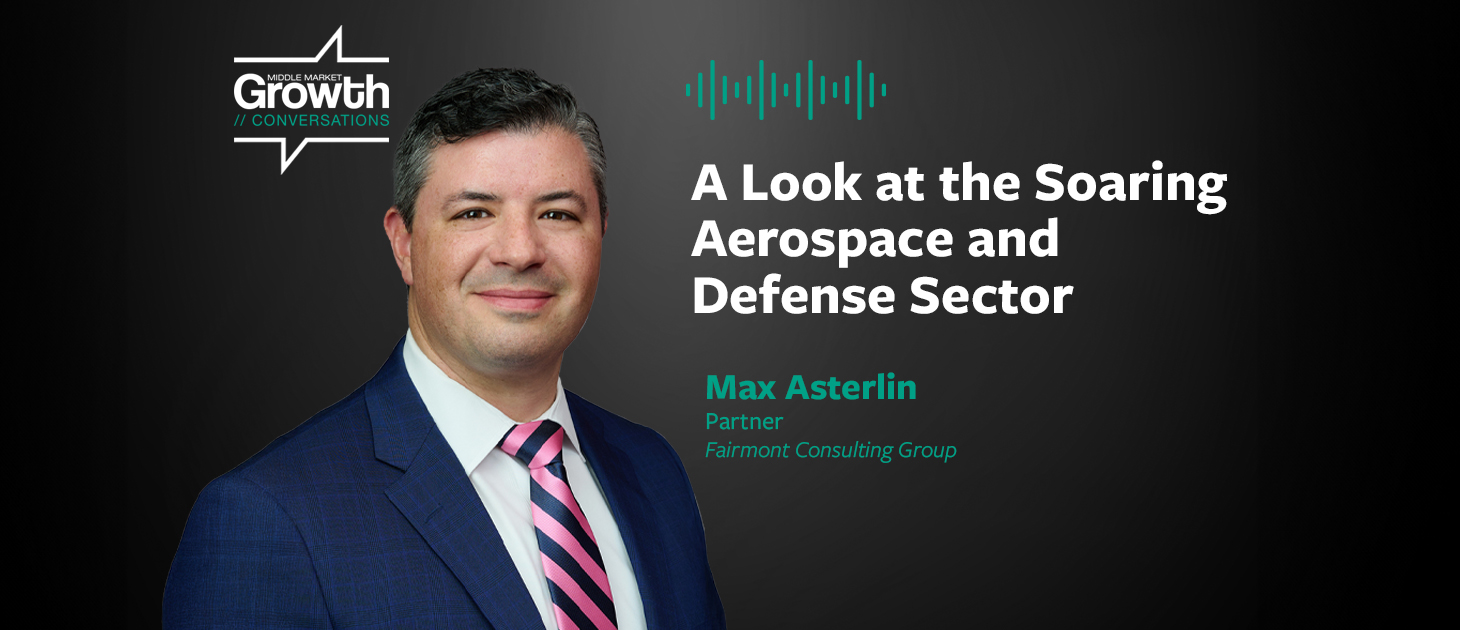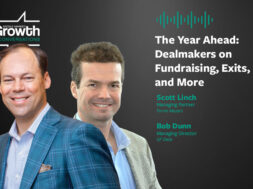A Look at the Soaring Aerospace and Defense Sector
Max Asterlin, partner with Fairmont Consulting Group, joins the Conversations podcast

The aerospace and defense (A&D) sector has seen solid growth in recent years, lifted by a new age of space exploration, Trump-era defense spending, and a renewed consumer demand for travel. On the podcast, Fairmont Consulting Group’s Max Asterlin dives into the risks, challenges, and opportunities developing in the A&D space. Catch Asterlin on Dec. 2–3 in Los Angeles at ACG’s A&D Forum, where he’ll be a featured speaker.
For more discussion of trends shaping the A&D space, read Middle Market Growth’s 2025 Aerospace and Defense Report and register for the 2025 ACG Aerospace & Defense Middle Market Leadership Forum, December 2-3 in Los Angeles.
Read a transcript of the podcast below.
Middle Market Growth: Welcome to Middle Market Growth Conversations, a podcast for dealmakers discussing the trends shaping the middle market. I’m your host, Carolyn Vallejo, and this is a production of the Association for Corporate Growth. If you’ve read Middle Market Growth’s 2025 Aerospace and Defense Report, you’ll know that the sector has steady momentum propelled by defense spending, private investment in space exploration, and continued demand for air travel, among other factors. Today we’re joined by Max Asterlin, partner with Fairmont Consulting Group to explore these and other trends in the sector and hear what attendees can expect from the A&D Forum taking place in Los Angeles this December. Max, welcome to the podcast.
Max Asterlin: Thank you very much, Carolyn. Really, really excited to be with you.
MMG: We’re excited to have you. And first we want to get to know you a little bit better. So, tell us about your role at Fairmont and your experience in the A&D sector.
MA: Sure. So, I’m one of the partners at Fairmont. Been with the company for almost its entire existence, about 13 years. I’ve worked my way up through the company. We, at Fairmont, most of the time are doing market advisory, usually in the form of merger acquisition support. So, helping folks understand the investment that they’re making, understand the assets that they’re looking at, and obviously with that, spending a lot of time thinking about the markets that they play in. And for Fairmont, we do focus just on aerospace broadly, the aerospace-defense fields, but strictly within aerospace, space, defense products and government services and throughout my time at Fairmont, have covered all of those markets, dealing with companies from $5 million enterprise value to $5 billion, you know, covered the gamut in terms of size. Prior to my time at Fairmont, I did spend about a decade with Pratt and Whitney. And so aerospace engineer by training, and spent a number of years there working on jet engines from both design and certification of new product introductions, namely F1 35 engine and the gear turbo fan, but also working field investigations and in infield design or upgrades on some of the legacy engines like the PW 2000 and the PW 4000 that are power plants for some main commercial transport aircraft.
MMG: All right, so you certainly have some hands-on experience, but I’m going to go out on a limb and guess that you were not an engineer for your first job. So just for a bit of fun, can you tell us what your first job was and a lifelong lesson that you took from it?
MA: Good question. Not an engineer but was a bit of an entrepreneur. So, in college I started my own small company making automated equipment for manufacturing lessons that I learned. You know, it was important there. I learned the value of understanding if you want to make a good product, and I think this pertains to anything, if you want to make a good product for somebody it’s really important to actually spend time with both the client, knowing what the product is doing and how it’s used, but also spend time in the weeds doing design and really understanding how it’s going to work. So, being in the weeds maybe was a bit of a life lesson.
MMG: So, let’s dive into the aerospace and defense sector. And I want to first talk about the aerospace component of this area. Tell me about some of the key sub-sectors, the niches in aerospace that you think are particularly promising right now.
MA: Yeah, I’ll probably include space a little bit in that as well, but aerospace is a really dynamic market. So, I mentioned of the four that we deal with, aerospace is probably one of the most attractive right now. Very much you have the return from COVID that has been propelling the market as it kind of returns back to secular growth, long-term trends, growth of air travel with the rising GDP across the globe of folks that are looking to commercially travel. And so, you have a lot of that return to the market that’s making it an attractive marketplace for businesses. Within that, MRO, the aftermarket spot is particularly interesting. A lot of investors are actively looking at that space. And then the OE portion, new build aircraft, that’s kind of finally returning since COVID, that has started to get back. And it seems like it’s every year it’s been something new that has been a negative, whether it’s Boeing and 737 challenges, whether it’s production and supply chain constraints that have been very pervasive in the last couple of years. It does feel like we’re starting to kind of get back to those build rates that the market is hoping for. And so now even the original equipment, the OE side of the aerospace market is returning. That’s definitely on the commercial side that a lot of those good trends are happening. But even on the military aerospace side, I’m starting to see a lot more of the next generation products, whether it’s on the large unmanned systems or the next gen six gen fighters that are starting to come out. A lot of real interest and optimism in those. The new bomber is starting to be produced. So, even on the military aerospace side, we’re also seeing some really nice and attractive trends.
MMG: Now, I know you mentioned new build aircraft, and we also saw that maintenance repair and overhaul, MRO, emerge as a particularly bright spot for investors in our report. Can you tell me about that niche and maybe some of the factors that are making it so attractive right now?
MA: Yeah, Carolyn, you’re absolutely right. Yeah, I think that’s probably been the hottest space for us in the last couple of years. Definitely a few notable drivers in that one, obviously, as I mentioned, the aftermarket will for sure be propelled by the general return to air traffic after COVID. And so, that’s a major secular driver. But then you have a number of other, I’d say subpoints that are really driving the aftermarket to outpace OE and outpace historical growth rates within the aerospace market. And some of those, deferred maintenance coming out of COVID that we really saw play out in kind of the 2022, 2023 timeframe. And I’d say that’s starting to normalize, but that’s been a real boon to the aftermarket for the last three years. But now two other areas or factors are continuing to, I think, buoy the aftermarket. One, because Boeing and Airbus have not been able to reach their production rates, it’s just meant that new aircraft aren’t getting into the system, and so old aircraft are needing to be flown longer than they were expected. So, you have these aged aircraft that are in the system that obviously need aftermarket support, but because they’re aged, they typically need even more aftermarket support, so that really supports the overall market. And then the other piece is new platforms, particularly the 737 Max, A320neo. As those have gotten into service, as with any new product, there’s new things, new unexpected things that have cropped up. A lot of it has to do with the engines, the new engines in those platforms. And those are also driving, I would say, unexpected maintenance events and maintenance dollars. And so, you put all those things together and it really is noticeable and notable that aftermarket continues to be a very, very strong market.
MMG: Previously you mentioned some manufacturing and military aircraft as an opportunity. So, using that as a segue into the defense side of aerospace and defense, can you tell me about some of the major trends you are keeping an eye on there?
MA: Defense side is really interesting. You know, you obviously have the national politics that kind of play into where funding is going. You have a backdrop of geopolitics that are very dynamic, and you know, have obvious drivers and factors within the broader defense spectrum. I’d say some of the things that we’re seeing and keeping a close eye on defense tech, a lot of people use that term, but broadly I would refer to that as some of the new players in the defense world. So, the Andurils, the SpaceX type of suppliers in the world, not the traditional primes, not the Lockheed Martins, the General Dynamics … They’ve continued to be really disruptive in offering new products, new engineering and development methods in the market that I think are different than the legacy players and I do think present challenges to maybe the legacy players. So, they’re winning a lot of competitions and they’re very interesting. I think it’s still yet to be seen whether they’re going to be able to deliver a lot of the promises that they had. But absolutely we’re seeing suppliers that are associated with those programs and customers that have incredible backlogs and incredible expectations of production related to those customers and platforms. So, that’s a very interesting topic within many of those defense tech players. The specific segment of unmanned vehicles is very much an interesting and hot one. But I would also say with unmanned, the markets of munitions and missiles, those three, unmanned, missiles, and munitions are three really, really active markets. A lot of new developments going on, a lot of interplay with geopolitics and some of the current overseas activities that are going on, whether it’s Russia and Ukraine in the Middle East, and also thinking about potential conflicts with Asian competitors. And so, all of those have a lot of interplay and there’s a lot of funding and new product development going there, so we’re keeping an eye on that. Naval is probably the third area that is really interesting right now. Lot of recognition in the Department of Defense for the U.S. to move faster in terms of naval production, but there’s a lot of supply constraints and it’s up and down the supply chain, whether it’s raw materials, whether it’s shipyard welders and fabricators that are needed, or even at the systems level, there’s a lot of constraints in that system and they all have to be able to work together to produce ships, whether they’re undersea or surface vessels at the rate that the Navy wants. And so that’s a real watch item to see if between the government and the private sector, they can actually address those supply chain constraints and then you would see the growth in the market that I think many are hoping for. So those are three interesting areas. On the downside, you’ve definitely seen a reduction in some of the government services areas, particularly some of the outsourced labor areas and so those have been sectors particularly early this year that have seen some, some negative trends. So, we’re keeping an eye on that to see how that shakes out and when those might turn around or at least where there begins to be a light at the end of the tunnel for some of those parts of the market. But those are kind of four areas that we’re paying really close attention to.
MMG: I want to go deeper for a few minutes into that collaboration opportunity between the private sector and the government, and I want to go back quickly to defense tech that you talked about just now. How much innovation and demand for defense tech services and products is being driven by President Trump’s golden dome proposal?
MA: Yeah, I’d say that one’s yet to be seen. So, we’re definitely seeing a lot of activity and some of our clients are talking about it. We’re actually looking at several things right now that are related to it, so there’s a lot of interest. There’s also a lot of uncertainty. And you know, I think some of the solution of the Golden Dome will be leveraging existing systems, so existing supply base and some of it will be new and novel products that will need to be developed for it. But I would say broadly there’s a lot of other parts of the defense tech world beyond just the golden dome missile defense broadly. You have a lot in that missiles, munitions, and unmanned space that some of those new disruptors are also looking to accelerate, and there’s a lot of favor within this administration for some of those new entrants, I think at the very least, to get new blood in the system and have different options. And some of those new players, I think they’ve won positions because they’re able and willing to move very fast and also maybe even put some development dollars on the table that aren’t strictly government funded. And, you know, I think that that has helped them, but it’s definitely across the board in those sectors where we’re seeing really interesting private sector solutions to these new emerging challenges within the defense department.
MMG: Right, there is a lot of support from the Trump administration, especially on the defense side. But one thing we also covered in our report is this interesting kind of dichotomy because while there is that support, there are also some challenges emerging for the private sector for innovators here, particularly when it comes to some personnel cuts that we saw earlier this year in the government. It’s created some uncertainties and delays in this area. So, what are your observations there in terms of how investors are navigating this opportunistic but also kind of challenging environment within the government?
MA: No, it’s a really good point. I would say broadly, those are kind of two parts of the market. A lot of the personnel cuts, a lot of the funding cuts that were pretty public early in the year, a lot of those were to services areas and outsourced services, so think about large government contractors that would come in and help with IT support and other normal administrative functions. And a lot of those contracts were under a lot of scrutiny that’s different than some of the investment accounts. And so, some of the new product development, we’re seeing funding still do well there. That’s where a lot of the supply base is. But absolutely, if you are one of those larger defense services players, it has been tough to navigate the first few innings of this new administration. The other thing that I would say has bled over into the broader product supply base is a lot of turnover and maybe a little bit of uncertainty and maybe just lack of organization on the procurement side. And so, what we have seen from a lot of suppliers is procurement contracting has been delayed and that has definitely impacted the broader supply base. So even if there’s money in the system to buy whatever your widget is, if there’s not a procurement officer there, or if that contracts officer has had high turnover, that always just causes a lot of inefficiency and delays in the systems and that’s a tough one for suppliers to navigate. I know it’s a headache. Many of our clients or many of the businesses that we look at, no real easy way, no easy solution for that one other than the procurement folks within the supplier base to just be as on top of their government counterparts as they can be. And you know, and I think particularly in areas of high turnover, you’re often maybe leading them more than following, you know, just to make sure that those contracts kind of continue to get pushed through the system.
MMG: Speaking of turnover, I want to talk about the human capital side of things. Perhaps one of the biggest concerns in the A&D sector right now is a pretty massive talent gap that several niches are experiencing, if not all. What’s driving this talent gap and what are some of the roles that are seeing the biggest shortages here?
MA: Yeah, it’s very much a consistent theme that we, we hear throughout the marketplace. I’ll take the second half of your question first. I think the biggest two areas that we hear the labor shortage a lot, biggest by far that we hear is in the skilled labor, so manufacturers, welders, maintenance technicians within the aerospace world. So, kind of this blue-collar, skilled-labor element. But the other one that we hear is in the high-tech side, so coding professionals, ones that are more maybe into the cyber part of the defense aperture. So those are kind of two areas that we see some shortages. I’d say that the contributing factors, you have this long running trend of aged workforce broadly within the aerospace defense, skilled labor pools that has really got exacerbated or highlighted maybe during the during COVID, where there’s a lot of really experienced labor lost and that has just been really, really slow to get back. And even when you are getting it back, you’re typically not doing it at a one for one, so you’re maybe replacing what was a very experienced person with a very inexperienced person. So, while you have a person they’re typically not as efficient or effective, at least in the near term. And so that’s been a challenge. Pipeline continues to be an issue that everybody, and this is nothing new, but everybody continues to think a lot about how you get more skilled students and young people coming out of colleges and schools ready for these types of jobs. And then the other one that I think has been growing as a reason for these shortages is just more competition particularly, and this I think is more in the high-tech area, a lot of competition from some of the tech companies. And you know, those obviously have really high paying jobs, great jobs in the private sector, and those become really, really competitive when you’re talking about those same types of skills going into defense contractors or into even DOD themselves.
MMG: So, these are pretty prolific challenges here. What are some of the most effective ways that you’ve seen companies address these talent shortages and human capital challenges?
MA: Everybody should be thinking about this, and it is something that we have seen more and more over the last maybe five years or so, where investors, as they look at assets, as they do diligence on assets, talent and supply of talent is becoming more and more a question during the diligence to ensure that if you have some growth metric, that you have a pipeline of people and personnel to support that in addition to capital and equipment that we always talk about. But now the personnel aspect is becoming more of a hot topic. I’d say what we’ve seen in the marketplace is trying to develop internal pipelines. You know, that’s how do you take what is such a big broad market topic and how do you do something that you can control as an individual company? So, working with local schools or local whether it’s a colleges or junior colleges, working with local schools to provide that pipeline or help to identify the right type of courses that are needed for those graduating students, developing internal apprentice and training programs. Those have been around for a long time, but I think more and more suppliers are recognizing that those are great tools to have and really allow you to control your own destiny. And then the other one is simply trying to increase retention through more profit incentives, whether it’s profit sharing or some sort of bonus offerings, but just trying to increase retention through of their high-quality labor. That’s obviously the best way to maintain is you’ve got to grow, but if you’re also losing and losing skilled workforce, it makes the challenge of keeping up doubly as difficult.
MMG: Alright. Well, our conversation today has touched on a lot of hot topics in A&D, but this is a very complex, rich environment as you’re well aware. And I know you’re going to be at our A&D Forum this December. In fact, I believe you’re a keynote speaker. Can you tell us a little bit about what attendees can expect from this event?
MA: I always look forward to coming to the forum. I think it’s a great place, particularly for midmarket investors that are thinking about these types of suppliers that are wrestling with these challenges. Always a great forum to talk through what opportunities and risks are there. I know a lot of speakers will give a lot of good information about different market perspectives as well as perspectives from the investor group. I’ll be talking a little bit about not only these markets, but maybe what are some of these trends that you can invest on? What are some of the waves to ride versus where there might be bubbles in the system and where might some of the trends not continue? And I’m excited to be talking about that, but it’s always a great event and very much looking forward to it again this year.
MMG: All right. Max Asterlin, partner with Fairmont Consulting Group, thank you so much for joining the podcast, and I look forward to seeing you at the A&D Forum.
MA: Yeah, Carolyn, I look forward to it as well. Thank you so much for having me today.
MMG: And for those of you listeners interested in joining us, the Aerospace and Defense Middle Market Leadership Forum will be held on December 2 and 3 at the Hilton Culver City in Los Angeles, California. You can learn more at acg.org. And for those who have not yet read the 2025 Aerospace and Defense Report, that’s available at middlemarketgrowth.org.
This transcript was prepared by a transcription service. This version may not be in its final form and may be updated.
The Middle Market Growth Conversations podcast is produced by the Association for Corporate Growth. To hear more interviews with middle-market influencers, subscribe to the Middle Market Growth Conversations podcast on Apple Podcasts, Spotify and Soundcloud.


